Animation Sensation: CATS DON’T DANCE Is Purrfect!

If there is one word that can sum up Dallas…
It’s funny what you can bond with others over. One such instance happened to me while I was at work, completing one of my routine tasks. I was strolling through the hallways when I passed one of my coworkers who had his headphones placed firmly over his ears and was humming a catchy, yet familiar tune. I had to pause for a second as I could recognize the song and yet could not quite put my finger on it. Then, whether it was from pure exuberance or tone-deafness, he blurts out “Big and loud! BIG AND LOUD!”
I smiled because I knew the song. Hoping to see if we could have some kind of discussion about it, I tapped him on his shoulder and responded, “Gonna make your momma proud!” continuing the next verse for him. His eyes gleamed and he had to force himself from squeeing in delight. “Oh my god, you know about Cats Don’t Dance?” He asked hands placed on his mouth in playful shock. “I love that movie!” And for the next ten minutes or so, we talked about this little hidden gem in animation and both begrudged that it was not receiving the attention it deserves. This is a shame, since Cats Don’t Dance is an imaginative, clever, and funny romp that is a big love letter to the Hollywood musicals of the 30s and 40s.
Danny the Song and Dance Cat
Hailing from the small town of Kokomo, Indiana, Danny (Scott Bakula) – a wide-eyed and idealistic orange tabby – has a dream. He wants to be a star in Tinsel Town, to make it to the Hollywood big leagues to become, in his words, “Danny the song and dance cat!” After an impressive musical number where he serenades through the streets of Hollywood, singing and dancing his dreams in exposition, he makes his way to an agent.
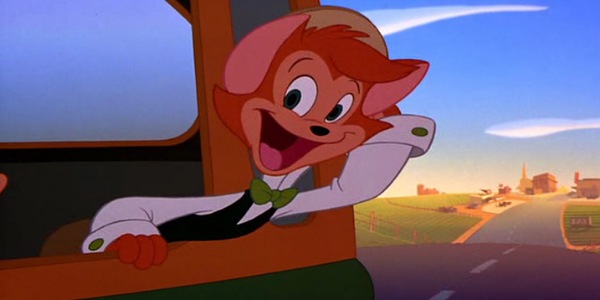
Right from the gate, the main crew is introduced to the viewer in the most frantic and energetically clever writing, where the jokes and dialogue come at us a mile a minute. One of the funniest characters, who only appears in this opening scene is Farley Wink (Frank Welker), a real fast talker of an agent who asks quick answers, demands rapid-fire comebacks, and views himself rather narcissistically as a dashing “Clark Gable type,” despite his rolly-polly build and balding head. You can’t deny, the man has confidence!
He signs Danny up immediately and it appears that his life is taking a turn for the better since he is on his way to becoming a star! Oh, but wait, he’s an animal – and Hollywood is a human town, where animals are given the worst gigs and viewed as second-class citizens. But Danny will turn this prejudiced town upside down and make a name for himself come hell or high water (that last part is not just figurative as you will soon see.)
Kid-Friendly Commentary
One of the best ways to broach topics and themes that may be over kids’ heads or seem too heady for younger minds is to utilize animals in fable-type stories. The usage of animals to tell tales goes as far back, as time immemorial, to such tales as Aesop’s Fables and continues to be utilized to this day. The fable that Cats Don’t Dance is trying to teach kids is twofold. One is simple (admittedly hackneyed) “always follow your dreams” and is, surprisingly enough, a history lesson in the bigotry and racism of the 1930s and 40s Hollywood.
Back in the day, actors who happened to be people of color were barred from leading roles and were typecasted as “yes massa” types that would make most modern audiences shake their heads. Hollywood has come a long way in terms of black and brown characters. But Cats Don’t Dance gives audiences, especially younger ones, a glimpse into what it was like for black actors in tinsel town. Much like life outside of Hollywood, black people were second-class citizens and were relegated to roles of being servants, maids, shoe shiners, dancers, or “magical negros” if they were fortunate; sometimes all within the same field – well aren’t you lucky?
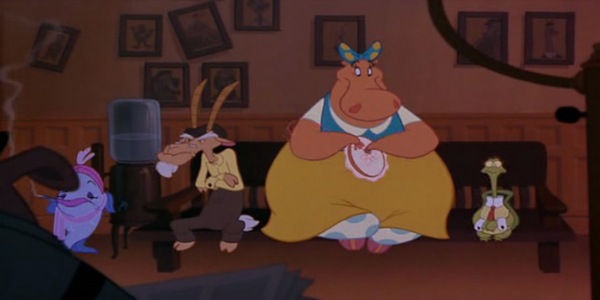
In the world of Cat’s Don’t Dance, animals are stand-ins for people of color and are relegated to humiliating roles in the entertainment industry. I have heard some associates state that if the studio wanted to truly stand out, instead of using animals, the animation crew should have used black human characters instead. While this would lend itself to realism, I believe Cats Don’t Dance is a fairytale, an allegory for just how corrupt tinsel town was in the past when it came to race relations. But this little film does not just touch upon metaphorical racism but also how some stars utilize their power to browbeat and bully those beneath them – an unfortunate problem in the entertainment industry that, in some ways, has gotten worse.
It is also not a coincidence that in the film, the animals live in what could be construed as a ghetto. The human characters live in – at the very least – standard housing that is up to snuff while the animals live in squalor. Surrounded by a series of run-down apartment high-rise buildings with ramshackle windows with clotheslines running across between windows and with little sunlight, the animals are on the skid-row of Hollywood. One scene, although brief, showcases the sense of community that the animals have with one another over their shared plight of being an underclass and that is the “animal jam session.”
The clever animation by using animals and their different natural attributes to add to the song makes it a bop that one cannot help but groove to. It’s also a funny scene with the villain Darla Dimple (Ashley Peldon) and her hulking man-servant Max (Mark Dindal), who, even with his usual stoic demeanor, cannot help but feel the music and want to dance along – until he is reprimanded by his boss. And speaking of Darla the antagonist.
The Devilish Darla Dimple
The characters in Cats Don’t Dance are a marvel of the marriage between fast and funny. When it comes to animated comedy, I am most drawn in when the jokes fly at break-neck speed and the animation matches to boot. Sometimes, with several of the characters, the jokes don’t land or seemed forced in regards to trying too hard to be ‘zany.’ When the jokes work, they stick the landing like an Olympian going for the gold. When they do not, it elicits a shrug from me. The scene where a flamboyant drama-queen version of King Kong comments on his latest picture is all I need to keep this animated ball rolling.
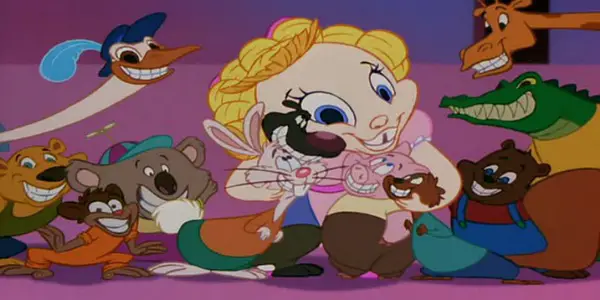
However, the princess of comedic timing in this picture is Darla Dimple, the ersatz Shirley Temple of the movie who appears to be a sweetheart on the camera but is nothing more than a little bat out of hell. The animators must have had a blast penning her because every scene she is in has me cackling with laughter. Darla is pure physical comedy in her presentation, whether it is a temper tantrum that causes her once adorable bow to curl into devil horns; an ear-piercing screech that sends her adversaries into a mess; or her ability to turn on her charm that simultaneously evokes dread because you know – the pain is not far behind if you dare say no. Her characterization is all the more impressive considering the fact that her voice actor at the time – Ashley Peldon – was only 12 and she already had the pipes to pull off such bratty screams and changes in tone. It is no surprise that Peldon‘stalent in screams would be utilized as sound effects in later productions.
But what would a vile egoist of a villainess be without her henchmen? Darla has only one, but considering who she has hired – one is all she needs. Enter Max, a literal mountain of a man who looks like King Kong (not the one mentioned earlier) and has the voice of someone who does an intimidating impression of Arnold Schwarzenegger. Max is the deadpan foil to Darla’s over-the-top exuberance and whenever these two are on screen, it’s Looney Tunes-styled gold. Think of similar stylings in slapstick animated comedy duos such as Yzma and Kronk from The Emperor’s New Groove and you get the idea.
A silly little fan theory of mine is that Darla is, in an actual sense, a real demon from hell, a little imp that is utilizing her power to gain earthly success. It would explain why, throughout the entire film, she is shown not having any parental figure in her life. Max, being her familiar, is a towering demon which would make sense since he seems to show up with little to no effort whenever she needs him and would account for his ungodly size and strength. One such scene which supports this frivolous idea of mine is how – after he is done doing Darla’s bidding – he just disappears in a flash of light. Mere cartoon antics? I think not! Darla is a demon and Max is her hellish servant – change my mind!
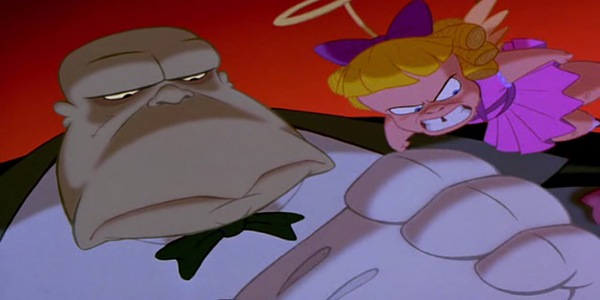
All fan-notions aside, after pouring so much into Darla and Max, some may think that the other characters seem to be nothing but stagehands. Not true at all. Danny, as it pains me to admit, is not the best leading character being a bit bland and one note. But he grows on the viewer over time and his sunny optimism and dedication to his dream, as well as his ability to draw out the talents in his fellow animals, makes it hard not to root for the guy. As for the other zany cast of characters, they all have their moment to shine with something to gravitate any viewer toward them.
Cranston (Hal Holbrook) the old goat is a crotchety representation of an elderly man complete with a “get-off-my-lawn” tone and a snide remark for everything around him. His gal pal (or potential love interest, who knows) Frances the Fish (Betty Lou Gerson) is a fabulous primadonna who has become jaded and is never seen without her long cigarette holder. The idea of a fish out of water constantly smoking is funny in and of itself. Tillie (Kathy Najimy) is the happy-go-lucky hippo who, aside from Danny, is second best in the Optimism Olympics – even if she sometimes bites off more than she can chew. T.W. Turtle is the nervous nellie of the group, a superstitious turtle who guides his life, via bibliomancy through fortune cookies and is voiced by the late great Don Knotts, meaning the comedy writes itself.
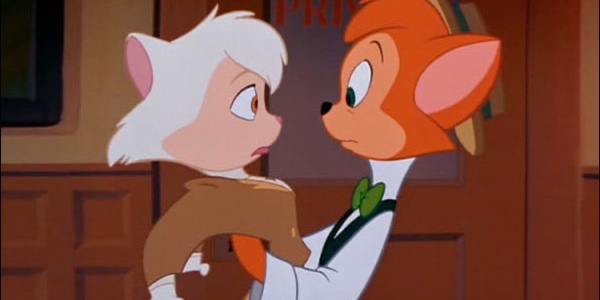
The best thing about this motley crew of animal misfits is how they play upon each other with their dialogue and just how relatable their struggle is. We all go through a sense of pessimism due to having dreams dashed or facing discrimination because of being different from others but the character who portrays this the best is Sawyer, the smart-talking, cynical Turkish angora cat who becomes Danny’s main squeeze. The voice actress behind Sawyer is Jasmine Guy and she provides just the right amount of snarky bite behind her words while still being smooth and approachable. Sawyer steals the show with – in my opinion – the best song of the movie, Tell Me Lies. And speaking of music.
A Toe Tapping Soundtrack
Why Cats Don’t Dance failed at the box office will be touched upon later, but one thing I don’t get is why at least the soundtrack is not given more attention. Cats Don’t Dance has some of the best songs in an animated film all of which would give the biggest Disney musical a run for its money. As much as I make fun of Randy Newman for his musical stylings, when he writes lyrics for songs, they can be superb – just keep him away from score composition lest you want just another repeat of Toy Story and his plethora of other tin pan alley inspired songs.
But in this movie, such stylings work in his favor because it is set in the 30s when Randy feels more at home. “Our time has come,” the first song of the film is nothing to write home about, but it is catchy. “Danny’s Arrival Song” is a love letter to the yesteryears of Hollywood classics with the vibrant sunniness of something one would see in several of Gene Kelly‘s pictures. Inspiration is not just the driving force since, no joke, Gene Kelly provided choreography for the animation before his death in 1996 and the film is even dedicated to him. Rest in power.
There are plenty of catchy songs throughout, but the one that gets me–my absolute favorite–is “Tell Me Lies” sung with soulful gusto by Natalie Cole and acting as Swayer’s big number. Natalie hits this one out of the park, showcasing the sadness, hopelessness, and broken dreams of Sawyer, who, for the longest time, has lost hope that she would ever be more than just another animal in a prejudiced world. But then the song moves towards hope when she alludes to Danny, urging her to keep trying, as the song states “Maybe something in his eyes just told me so.” It may be a short song, but there is plenty of character development within and subsequent growth that comes around with it. It’s a number befitting the raw talent that Natalie Cole has.
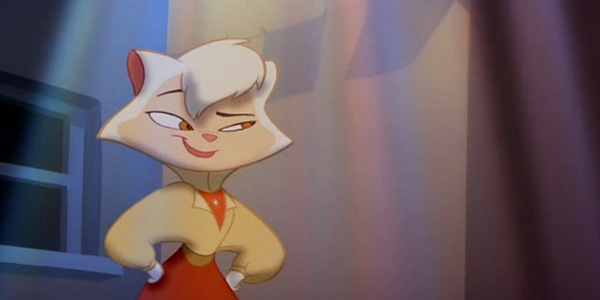
But the bangers don’t stop there, since the showstopper that topples both Darla and the prejudiced status quo of Hollywood is “Nothing’s Gonna Stop Us Now.” This is where all of the main characters get to strut their stuff and sing their hearts out. The song is also a showstopper in the comedic field since Darla is doing everything she can to bring their performance to a screeching halt and unintentionally making it better along the way. It’s the classic comedy-of-errors routine that fits right at home with the Looney Tunes aesthetic that the humor this film is going for. It is the perfect means to end what is a rip-roaring ride of an animated film.
Why Did It Fail?
With a fast-paced sense of humor, old-styled and eye-catching animation, and a stellar soundtrack, Cats Don’t Dance should have been a hit but it was an abysmal failure at the box office. Cats Don’t Dance made a measly 3.5 million at the box office against a budget that was a whopping 32 million. With the hallmarks of classic Hollywood musicals and the stylings of Looney Tunes, it baffled me at first as to why this film was a flop. Then in donned on me.
Cats Don’t Dance didn’t know which audience it wanted to pull in. On the one hand, it was a big wet kiss to the golden age of movies and this would appeal to an audience that – for the most part – has passed on to the golden paved streets of heaven. On the other hand, it features humor and talking animals that would undoubtedly draw in a younger audience but lacks anything from modernity that would add to relatability for such a crowd. One such example of a successful animated feature that has talking animals (and came out roughly around the same time) was A Goofy Movie. The world of that movie was populated entirely by talking cats and dogs and filled with songs, but since it was set in (for the time it was released, at least) the present day and featured a classic Disney character that everyone in the audience grew up with, it was not a gamble to make A Goofy Movie. It was a joining of the old and the new that Cats Don’t Dance lacked.

Ironically enough, Cats Don’t Dance was released at the wrong time and might have been more of a success if it were released today. In our turbulent times, many consumers are in a nostalgic frame of mind, and while it might be a stretch to say that audiences are fiending for the yesteryear Tinseltown trappings of 1930s Hollywood. But then again, with how popular the aesthetics of something as old as Victorian England has become in recent memory, it is not that far of a stretch. In our current nostalgia-driven age, it is not far from the realm of possibility that music and movies from the 30s and 40s would garner more of a reappraisal and appreciation as time goes on.
However, maybe I am reading into this more than I should since, the simpler reason why Cats Don’t Dance was a financial failure is that the marketing campaign was weak, to say the least. The movie was released with no fanfare and aside from a few kids’ meal toy runs at certain fast-food places, many did not even know that Cats Don’t Dance even existed. Critic response was, for the most part, positive but it was not enough to get the required butts in the seats to make the flick a blockbuster. It is the hope of this feature that animation buffs, fans of older films, and theater geeks will give Cats Don’t Dance a second look. The good news is that, as of the writing of this, Cats Don’t Dance is available to watch for free (and legally) on YouTube so you too can join in on singing along to this toe-tapping, knee-slapping, and underrated little gem. As Danny would say, “See you in the movies!”
Cats Don’t Dance was released on March 26, 1997
Watch Cats Don’t Dance
Does content like this matter to you?
Become a Member and support film journalism. Unlock access to all of Film Inquiry`s great articles. Join a community of like-minded readers who are passionate about cinema - get access to our private members Network, give back to independent filmmakers, and more.
If there is one word that can sum up Dallas Marshall, it would be weird. He is a strange fellow who is also a writer, anime nerd, and film buff who can also talk for hours about mythology and out-there literature. He has been sighted at local used bookstores perusing for horror books and manga. He has also written a book about Japanese animation called Anime Adrenaline! Which can be found on Amazon. You can also catch him on his own website at www.Dallasthewriter.com













